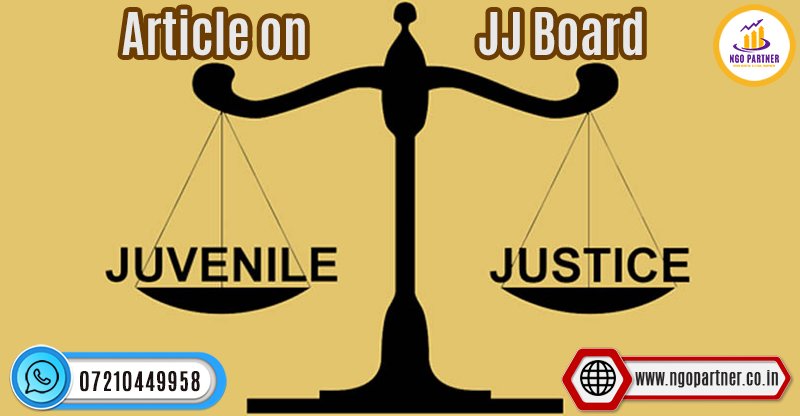
- June 13, 2023
- NGO Partner
- 0 Comments
- 1422 Views
- 0 Likes
- Marketing Company Blogs
Juvenile Justice Board: The Rights of Children
Juvenile Justice Board
Children are the future of any society, and their rights and well-being should be at the forefront of our concerns. In India, the Juvenile Justice Board plays a pivotal role in ensuring the protection, rehabilitation, and reintegration of children in conflict with the law. This specialized judicial body holds immense significance in safeguarding the rights and welfare of children who have come into contact with the criminal justice system.

The Juvenile Justice System in India is designed to address the unique needs and vulnerabilities of juvenile offenders. It recognizes that children, due to their age and circumstances, require a different approach that focuses on their rehabilitation rather than punishment. By emphasizing the principles of care, protection, and guidance, the Juvenile Justice System aims to create an environment that promotes their overall development and ensures their reintegration into society.
In this blog, we will delve into the Juvenile Justice Board, exploring its role, functions, and impact within the broader framework of the Juvenile Justice System in India. We will examine the legal provisions, procedural aspects, and the rights of juveniles involved in the justice process. Additionally, we will discuss the challenges faced by the Juvenile Justice System and potential reforms to strengthen its effectiveness.
Understanding the Juvenile Justice Board
The Juvenile Justice Board (JJB) plays a crucial role in ensuring the protection and rehabilitation of children in conflict with the law. As a specialized judicial body, it is responsible for handling cases involving juveniles and ensuring their rights and welfare are upheld.
The JJB is composed of a Metropolitan or Judicial Magistrate and two social workers. This composition ensures a multidisciplinary approach, combining legal expertise with social understanding. The board conducts inquiries, makes necessary orders, and takes decisions regarding the rehabilitation and reintegration of juveniles.
Legal Framework and Provisions
The JJB operates within the legal framework provided by the Juvenile Justice (Care and Protection of Children) Act, 2015. This act lays down the procedures and principles for dealing with juvenile offenders.
Under the act, the JJB conducts inquiries in a child-friendly and informal manner, ensuring the rights of the child are protected throughout the process. It focuses on the rehabilitation and social reintegration of juveniles, aiming to prevent further criminal behavior.
The JJB has the power to pass a range of orders, including placing the child under probation, sending them to a special home, or granting bail. It also plays a crucial role in monitoring the progress of juveniles after their release, ensuring their successful reintegration into society.
By recognizing the unique needs and vulnerabilities of juveniles, the Juvenile Justice Board seeks to provide a supportive and rehabilitative environment for their growth and development. It aims to address the root causes of their involvement in criminal activities, such as poverty, neglect, or lack of education, and help them become productive members of society.
Role and Responsibilities
The Juvenile Justice Board (JJB) holds a critical role in safeguarding the best interests of children in conflict with the law and promoting their rehabilitation. The board is responsible for making informed decisions and taking appropriate measures to ensure the welfare and well-being of juveniles.
One of the primary responsibilities of the JJB is to assess the circumstances of each case and evaluate the needs of the juvenile involved. This assessment helps in determining the most suitable course of action to address their rehabilitation, including education, counseling, skill development, or community service. The board works towards creating an individualized rehabilitation plan tailored to the specific needs of each juvenile.
The JJB also ensures that the principles of natural justice are upheld during the decision-making process. It provides juveniles with an opportunity to be heard, considers their perspective, and takes into account their wishes and opinions when determining the course of action. This approach empowers juveniles by involving them in the decision-making process that directly impacts their lives.
Procedure and Rights of Juveniles
In line with the principles of fairness and justice, the Juvenile Justice Board follows a procedural framework that respects the rights of juveniles. One of the fundamental rights afforded to juveniles is the right to legal representation. They have the right to seek legal counsel and have their case presented before the board by a competent advocate. This ensures that their interests are adequately protected and represented during the proceedings.
Confidentiality is another crucial aspect of the juvenile justice system. The identity and personal information of the juveniles are protected, safeguarding their privacy and minimizing any potential stigma or discrimination they may face. The JJB ensures that the proceedings are conducted in a child-friendly environment, free from intimidation or coercion.
Juveniles also have the right to be informed about the charges against them, the evidence presented, and the decisions made by the board. They have the right to present evidence, call witnesses, and cross-examine witnesses, providing them with a fair opportunity to defend themselves.
Challenges and Reforms
While the Juvenile Justice System in India has made significant strides, it faces several challenges that hinder its optimal functioning. Overcrowding in juvenile homes, resource constraints, and delays in the disposal of cases are some of the persistent challenges that need to be addressed. These challenges not only affect the efficiency of the system but also impact the well-being and rehabilitation of the juveniles.
To overcome these challenges, there is a need for comprehensive reforms. Strengthening the infrastructure of juvenile homes, increasing the availability of trained personnel, and expediting the disposal of cases through the establishment of fast-track courts are some measures that can enhance the effectiveness of the Juvenile Justice System.
Additionally, promoting alternative forms of dispute resolution, such as mediation and restorative justice practices, can provide more holistic and rehabilitative approaches to dealing with juvenile cases. This encourages the active participation of all stakeholders involved and focuses on the restoration of relationships and reintegration of juveniles into society.
Continuous training and capacity-building programs for Juvenile Justice Board members and other stakeholders are essential to ensure a deep understanding of child psychology, social issues, and evolving legal frameworks. Regular monitoring and evaluation of the system’s performance can help identify areas that require attention and facilitate evidence-based reforms.
By addressing the challenges and implementing necessary reforms, the Juvenile Justice System can better fulfill its purpose of providing effective rehabilitation, ensuring the rights of juveniles, and nurturing their potential for a brighter future.
In conclusion, the Juvenile Justice Board plays a vital role in safeguarding the rights and well-being of children in conflict with the law. We discussed its functions, procedural framework, and the significance of balancing rehabilitation and accountability. By ensuring fair treatment, legal representation, and individualized rehabilitation plans, the board aims to foster the reintegration of juveniles into society. It is our collective responsibility to support and contribute to their rehabilitation journey. By advocating for reforms, volunteering, or promoting awareness, we can create a more inclusive and compassionate society that recognizes the potential for positive change in every young life. Let us stand together in nurturing and empowering our juveniles, shaping a brighter future for them and our communities.
Related: Child Labour Act 1986



Leave a Comment